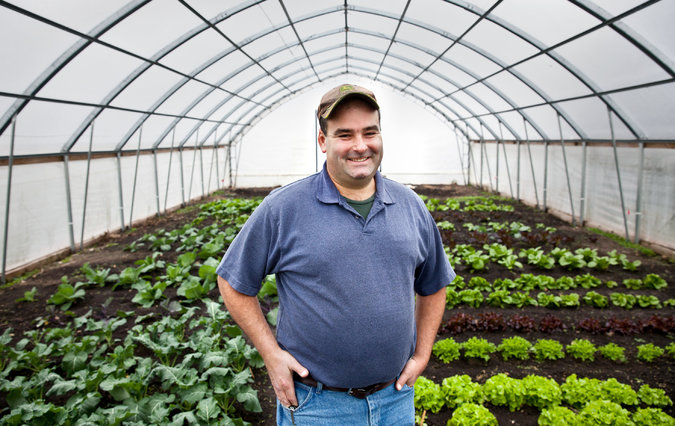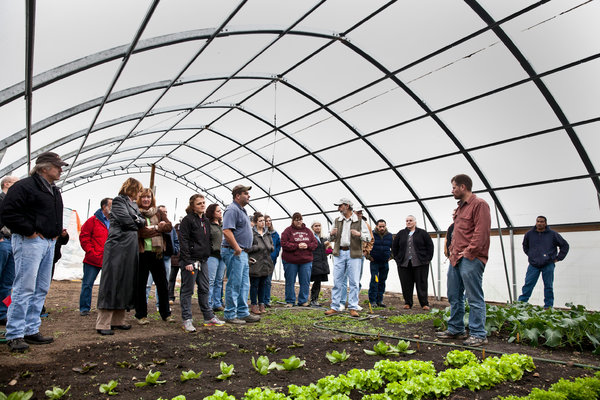
John D. Jackson lives in the heart of the Corn Belt, where most of the corn has nothing to do with sweet kernels on the cob. His farm in Southern Illinois typically grows field corn, the high-starch variety that is turned into ethanol and cattle feed. He also works as a logistics manager for Archer Daniels Midland, the agricultural giant that produces the other big artifact of this crop: high fructose corn syrup.
But on 10 of his 700 acres, Mr. Jackson broke from this culture of corn last fall by planting something people can sink their teeth into. With a tractor and an auger, he drilled four-foot holes in his soil, added fertilizer and put in 48 apple trees bearing Gold Rush, Jonagold, Enterprise and the sweet-tart blushing globe called the Crimson Crisp. This year he plans to add more apple trees, blackberry bushes and possibly some vegetables.
Mr. Jackson is part of a small but eager cadre of corn farmers who are starting to switch sides, as it were, lured by a little-appreciated fact of farm economics: There is vastly more money to be made in growing other vegetables and fruits. While an acre of corn is projected to net average farmers $284 this year after expenses, and just $34 if they rent the land, as is common, an apple orchard on that same acre will make $2,000 or more, according to crop analysts. A sophisticated vegetable operation using the popular plastic covers called high tunnels, which increase yields and extend the growing season, can push that figure as high as $100,000.

Until recently, farmers in the nation’s heartland could only dream about such profits because there were so few ways to sell their produce locally. California dominates vegetable production, with a vast infrastructure of distribution and transportation to stores coast to coast. But the rising demand for fresh, indigenous produce has spawned new markets — from grocers to restaurants to school cafeterias — that are making it possible for more Midwestern farmers to give fruits and vegetables a go.
The success of this movement, still in its toddler stage, could affect more than just the farmers. Field corn, bolstered by subsidies and corporate research, now dominates American agriculture and constitutes much of what we eat in processed foods. A turn toward locally grown produce would lessen the dependency on California (now plagued by drought), slash carbon emissions from trucking, make produce available to more people, increase its appeal through freshness and perhaps even lower prices.
Indeed, even as the federal government urges Americans to double their consumption of produce for better health, the amount of farmland devoted to it has slipped over the last decade, federal statistics show — to about 1.8 million acres in 2012 for the top 25 vegetables, from 1.9 million acres in 2002, and to 2.8 million acres of main fruits including citrus in 2012, from 3.2 million in 2002.
By comparison, plantings of field corn surged to a record 97 million acres in 2012, from 79 million in 2002 — or roughly 20 times the amount of land given over to other vegetables and fruits.
This imbalance could be in for a modest change. A glut in corn has sent prices tumbling to near $4.50 a bushel, from $8 in 2012, and while farm economists are not expecting a torrent of converts to produce, a wide variety of farmers are already coping with tough economic times by hedging their bets with berries and beets.
Throughout the Midwest, where dairy farmers face a host of financial challenges, two dozen Organic Valley Co-op members now grow fruits or vegetables or both on the side. In western North Carolina, ending government support has led an estimated 200 to 300 tobacco growers to plant produce, says the Appalachian Sustainable Agriculture Project. And in Iowa, a generation that left the farm to pursue other careers is returning, but with its own ideas.
“The children of corn farmers are coming back to the farm, and carving out 5 or 10 acres to grow fruits and vegetables,” said Craig A. Chase, the local food and farm coordinator at Iowa State University. “They can easily make $30,000 to $40,000 a year.” While their numbers are too small to be reflected yet in farm data, this new passion for produce is evidence that government and private efforts to nurture new markets in the nation’s heartland are starting to pay off, federal officials said.
“It’s really exciting to see farmers trying out these new opportunities, and it’s rewarding to know the U.S.D.A. can assist,” said Elanor Starmer, the Department of Agriculture’s national coordinator for local and regional food systems.
Midwestern grocery chains have begun promoting the advantages of local produce to shoppers, just as East and West Coast stores have been doing for years, and are teaming up with farmers to ensure a steady supply. These deals can include the occasional truckload of cucumbers, or the one million pounds of tomatoes, leafy greens and herbs that a Missouri-based chain, Schnuck Markets, has agreed to buy each year from a two-acre greenhouse under construction in St. Louis. The builder, BrightFarms, based in New York City, has similar greenhouse-to-grocer projects underway in Oklahoma City and St. Paul, and said it was striving to hire local farmers.
Schools, nudged by new federal rules that require healthier snacks and lunches, are seeking more local produce, and the Pentagon has stepped in to help, using the same logistics that supply its military bases. The system, called DoD Fresh, uses distributors who connect schools to farms; up to one-fifth of the $100 million in produce that traveled through this system last year was locally grown, according to the Department of Agriculture, which oversees this effort as part of its budding farm-to-school program.

Seven school districts in Chicago, Detroit and other Midwestern cities have also united to increase their purchasing power, organized by a New York City-based group called School Food Focus that aims to tap the production of midsize local farms.
The smallest farmers are also getting new help in selling crops to restaurants. Starting last year, a food advocacy group, the Illinois Stewardship Alliance, held seven “farmer mixers” in the state; growers, typically modest men of few words, found themselves pursued by chefs craving microgreens and other fresh fare.
“It’s the speed dating of farm to fork,” said Thad Morrow, the owner and chef of Bacaro in Champaign, Ill., who scored a steady supply of Thumbelinas and other unusual carrots at one such event by wooing the grower. “You have to extract information from these guys. He was sitting next to me, and was growing the carrots as something of an experiment, and he said, ‘You mean you might want these?’ ”
To sell his apples, Mr. Jackson plans to tap into one of the more unusual new outlets: the corporate C.S.A., or community-supported agriculture. Many of his colleagues at the Archer Daniels Midland plant and headquarters in Decatur, Ill., 200 miles from his farm in Galatia, were already ordering sweet corn delivered to their parking lot when he began asking them about apples. He found huge interest. “One man said to me, ‘Here is an apple my wife bought at a store, for $1 apiece, and they taste terrible,’ ” Mr. Jackson said. “I can beat that price, with great taste.”
Growing that kind of produce has its disadvantages. It requires far more work than growing corn, which is usually managed with farm machinery and requires little planning, marketing or even irrigation. So last year, Mr. Jackson attended a new series of classes aimed at teaching the ins and outs of fruits and vegetables.
Organized by Richard Weinzierl, a crop sciences professor at the University of Illinois, the Saturday classes are held in three locations around the state, with topics like pesticide drift, pathogen control and high tunnel construction, and had about 90 students in all.
“I would say they’re most surprised by the range of varieties of the crops they might grow,” Mr. Weinzierl said in an interview. “And that when it comes to marketing, a tomato is not a tomato is not a tomato. Heirlooms are priced higher but harder to grow, and the people taking these classes are interested in helping poorer folks eat better, too, so they might want to look at lower-priced hybrids for that reason, too.”
The classes, which began anew in December, are drawing a wide variety of would-be produce farmers, including people with large gardens; 1 in 10 students is a farmer who now grows corn or the other common field crop, soybeans.
Corn farmers who have made the switch say that for all the added work, growing fruits and vegetables is incredibly rewarding in ways other than profits. Tim B. Slepicka, who attended the classes, slid into the booth of a diner last summer in St. Charles, Ill., about an hour’s drive west of Chicago, to talk about his budding conversion from corn. But first he plunked his day’s pickings on the table with a huge grin. “Just taste this cucumber,” he said, gnawing one in his other hand.
To these he added tomatoes, a variety called Mountain Fresh, and some just-picked ears of raw sweet corn for eating, which he did, right there in the booth. To Mr. Slepicka, perhaps the biggest benefit of seeing more local produce being grown by farmers like himself is the prospect of offering shoppers not only higher quality food, but perhaps even lower prices through direct marketing. A 2009 survey in Iowa found that the mean price for a pound of vegetables at farmers’ markets was comparable to that of nonlocal produce sold by grocery stores. With organic produce, informal surveys have found that farmers’ markets and C.S.A.’s can even beat store prices.
“It’s a good feeling,” he said. “Especially knowing that one in six people are using food stamps. They’re looking for the least expensive calorie possible, and why should a pound of tomatoes — which are basically seed, dirt and water — have to cost as much or more than a frozen meal?”